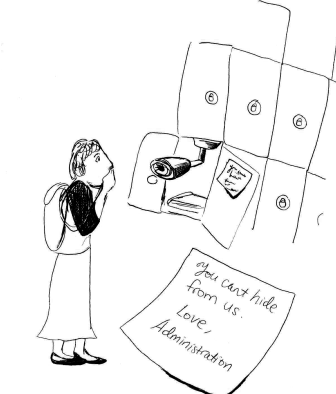
Aragon installed 32 more security cameras over the summer, totaling more than 60 cameras around the school.

Aragon first installed security cameras in 2008, in response to break-ins of the old newspaper and yearbook office, the locker rooms and library, as well as vandalism in the parking lot. Dean Michael Valmonte says, “Making campus safer, protecting the facility and protecting private and public property were the main reasons for the [added] security.”
“Installing cameras at that time was quite a project,” says Kirk Black, the Associate Superintendent of San Mateo Union High School District and Aragon’s principal at the time of installation. “There were no wireless cameras, so we had to run cables all around the school.”
Black says, “At the same time that we installed the security cameras, we installed fake [cameras], so it [looked] like much of the campus was under surveillance when, in actuality, very little of it was.”
Cameras have not been placed inside the locker rooms due to issues of privacy, nor in classrooms.
Valmonte and the campus aides are trained at viewing and retrieving the footage. They check the footage caught by the high-definition cameras after reports of theft or vandalism.
Although anyone can request to view the footage, Valmonte will only honor what he deems to be reasonable requests. He says, “If [students] expect the cameras to compensate for carelessness, [they won’t] learn personal responsibility.”
Junior Langston Swiecki states that a flaw of the security cameras is that they cannot deter certain crimes. He says, “If you’re determined and have the resources, you will commit the crime. [For example,] it’s not practical security against school shootings.”
Valmonte says, “The presence of the cameras causes people to think twice.”
So far, he has seen a decrease in the amount of vandalism and property theft. The money saved by the decrease in property damage has made the cameras a good investment, he says.
The cameras have mainly been used to monitor high-crime areas around the school, particularly around the locker room areas. For example, Valmonte states that $600 was recovered when a perpetrator was caught on camera.
Science teacher Arron Apperson used the cameras to find out who dented his car in the student parking lot. “Because we were able to catch the person that dented my car, I was able to have their insurance company pay $500, the deductible essentially, for my insurance. So it wasn’t $500 out of my pocket for an accident that I didn’t have anything to do with,” he says.
In addition, Valmonte says, “[The cameras have] spotted outsiders coming on campus, which lead to their arrest.”
“[The cameras] also made the campus safer as students who were prone to bullying were reluctant to engage in that type of behavior because they were informed that we had security cameras, but they didn’t know where all of them were,” adds Black.
So far, there has only been one incident of vandalism of the cameras themselves. Someone covered up a cameras while attempting to vandalize a bicycle. In addition, criminals have covered their faces to avoid being caught on camera. However, Valmonte says, “We don’t necessarily need a face to identify a person.”
Valmonte tries to avoid telling perpetrators that they were caught on cameras. He says, “Mentioning that they got caught on cameras is always a last resort because there is a tendency to tell other students who will be more sophisticated and figure out ways to circumvent the cameras.”



